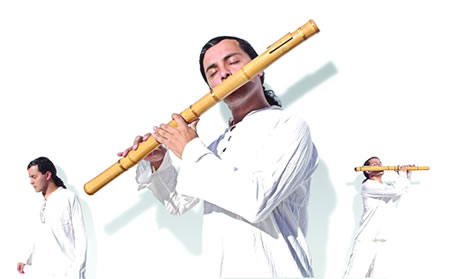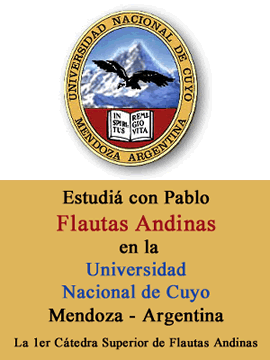
World Flutes Master
Peace web theme set courtesy of Crystal Cloud Graphics web set icon
Crystal Cloud Graphics
Crystal Cloud Graphics


Cuidemos
el Medio Ambiente
el Medio Ambiente

comprar

Tsuur
West Mongolia, Chinese Sinkiang region and Tuva Republic.
This is one of the most ancient musical instruments of the nomads and is now on the verge of disappearing. It is found among the Uriankhai ethnic group in western Mongolia and among ethnic Mongolians in the Chinese Sinkiang region. Structurally, the instrument is simple, but quite distinct from other wind instruments. It is about 58-60 cm in length, made of Siberian cedar, and consists of a tapered hollow tube in two sections, with a bell-shaped horn.
The maker cuts the selected pieces of wood into two equal parts and hollows them out. The upper section is thinner than the lower one. The two parts are joined together and three holes are bored. The spaces between the holes are measured by the fingers. The tsuur is played using lips, teeth and tongue. The mouthpiece is placed between the teeth and covered with the upper lip; the performer takes a deep breath and, by contracting his throat muscles, creates the pressure for blowing. This produces a gentle tone like the sound of a waterfall.
In old days, herdsmen offered their melodies to nature on the occasion of the New Year, playing the instrument on the tops of mountains.
The instrument was popular during the Hun State period according to Chinese historical records. Now, Narantsetseg is the only old man who knows how to play the instrument in Mongolia. The preservation of this unique musical instrument is very important not only for Mongolians, but also for Central Asians.
Asia/Pacific Cultural Centre for UNESCO (ACCU) Courtesy
West Mongolia, Chinese Sinkiang region and Tuva Republic.
This is one of the most ancient musical instruments of the nomads and is now on the verge of disappearing. It is found among the Uriankhai ethnic group in western Mongolia and among ethnic Mongolians in the Chinese Sinkiang region. Structurally, the instrument is simple, but quite distinct from other wind instruments. It is about 58-60 cm in length, made of Siberian cedar, and consists of a tapered hollow tube in two sections, with a bell-shaped horn.
The maker cuts the selected pieces of wood into two equal parts and hollows them out. The upper section is thinner than the lower one. The two parts are joined together and three holes are bored. The spaces between the holes are measured by the fingers. The tsuur is played using lips, teeth and tongue. The mouthpiece is placed between the teeth and covered with the upper lip; the performer takes a deep breath and, by contracting his throat muscles, creates the pressure for blowing. This produces a gentle tone like the sound of a waterfall.
In old days, herdsmen offered their melodies to nature on the occasion of the New Year, playing the instrument on the tops of mountains.
The instrument was popular during the Hun State period according to Chinese historical records. Now, Narantsetseg is the only old man who knows how to play the instrument in Mongolia. The preservation of this unique musical instrument is very important not only for Mongolians, but also for Central Asians.
Asia/Pacific Cultural Centre for UNESCO (ACCU) Courtesy
Publication and textual documentation
J. Enebish
1985 "The interrelations of the tsuur and hoomii and singing manner of epics." Report presented at the Asian Music Symposium and festival.
Ulaanbaatar.
Audio documentation
Audio-visual fund of the Research Institute of Arts and Culture, private collection of J. Enebish, Ethnomusicologist, 1975-1988.
Visual documentation
A documentary film The Wooden Tsuur of the Huns, J. Enebish, 1994.
Institution/organisation involved in preservation and promotion
Mongolian University of Arts and Culture, its Research Institute of Arts and Culture
Researchers and Supporters Society for Mongolian Traditional Arts
Baga toiruu-26, Ulaanbaatar-210646, Mongolia
Data provider
Dr. Jambalyn Enebish
Scientific secretary
Research Institute of Arts and Culture
Mongolian University of Arts and Culture, Researchers and Supporters Society for Mongolian Traditional Arts
Address: Baga toiruu-26, Ulaanbaatar-210646, Mongolia
J. Enebish
1985 "The interrelations of the tsuur and hoomii and singing manner of epics." Report presented at the Asian Music Symposium and festival.
Ulaanbaatar.
Audio documentation
Audio-visual fund of the Research Institute of Arts and Culture, private collection of J. Enebish, Ethnomusicologist, 1975-1988.
Visual documentation
A documentary film The Wooden Tsuur of the Huns, J. Enebish, 1994.
Institution/organisation involved in preservation and promotion
Mongolian University of Arts and Culture, its Research Institute of Arts and Culture
Researchers and Supporters Society for Mongolian Traditional Arts
Baga toiruu-26, Ulaanbaatar-210646, Mongolia
Data provider
Dr. Jambalyn Enebish
Scientific secretary
Research Institute of Arts and Culture
Mongolian University of Arts and Culture, Researchers and Supporters Society for Mongolian Traditional Arts
Address: Baga toiruu-26, Ulaanbaatar-210646, Mongolia









